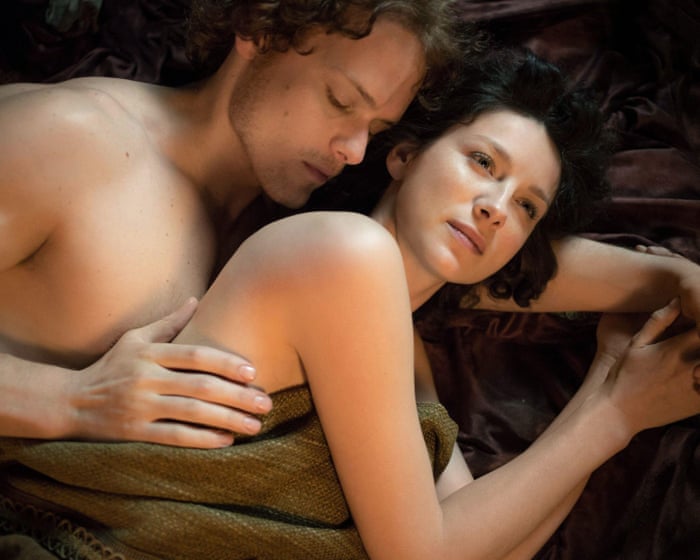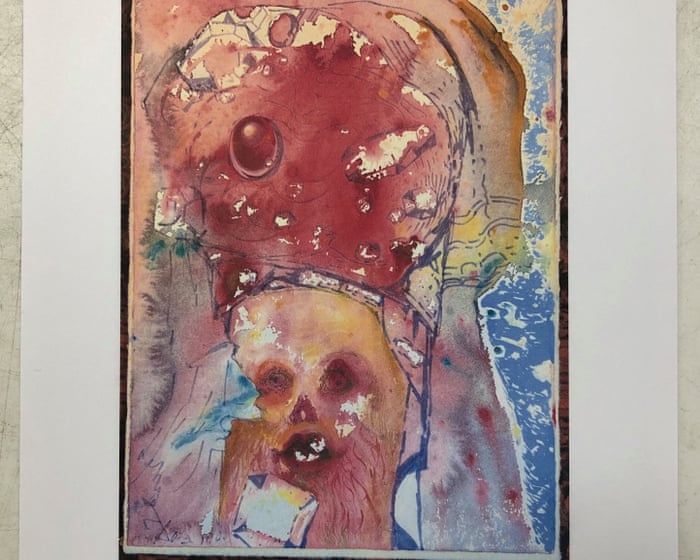Outlander first hit our screens in 2014, with critics quickly praising its steamy love scenes as some of the best on TV. The show follows Claire (Caitriona Balfe), a WWII nurse who time-travels to 18th-century Scotland and falls for rugged Highlander Jamie (Sam Heughan). Their chemistry is electric—from Claire’s explosive wedding night orgasm (complete with a fainting-worthy impact) to a memorable “castle cunnilingus” scene and even a life-saving intimate moment. The series became so popular that its eighth and final season is set to air in 2026.
Lately, period dramas have gotten even steamier. Shows like Carême, featuring a Napoleonic-era chef with a penchant for whipped cream foreplay, and Mary & George, packed with orgies and royal intrigue, prove the trend is alive and well. Outlander even spawned a prequel, Blood of My Blood, exploring the passionate (and time-traveling) love stories of Claire and Jamie’s parents—complete with a tabletop romp within the first half-hour.
But it wasn’t always this way. Thirty years ago, period dramas were far more restrained. The iconic moment from the 1995 Pride and Prejudice adaptation—Colin Firth’s Mr. Darcy emerging from a lake in a wet shirt—was scandalous at the time, despite no nudity. The chemistry between Firth and Jennifer Ehle (Elizabeth Bennet) was undeniable (they even dated in real life), and though the series kept things chaste, writer Andrew Davies found ways to hint at passion, later joking about looking for “any excuse to get some of that kit off.” The show’s impact was huge—Firth’s shirt even sold at auction for £25,000.
By 2002, the genre took a bolder turn with Tipping the Velvet, an adaptation of Sarah Waters’ lesbian romance set in Victorian England. The story follows Nan (Rachael Stirling), an oyster girl drawn to androgynous performer Kitty (Keeley Hawes), leading to a passionate affair. Critics were divided—some called early sex scenes “dull,” but things heated up when Anna Chancellor arrived as dominatrix aristocrat Diana, complete with a notorious leather prop. Chancellor, who’s never watched the show, admits filming was physically challenging but says it earned her a devoted LGBTQ+ fanbase—something she cherishes.
The series broke ground for queer representation, though Chancellor notes it was directed by a straight man—something she doubts would happen today. Intimacy coordinators weren’t common then either, but she acknowledges their value in crafting believable physical relationships on screen.
Soon after, historical accuracy took a backseat to passion in shows like The Tudors (2007), where Jonathan Rhys Meyers played Henry VIII as a smoldering sex symbol—proving that when it comes to period dramas, steam often trumps strict history.In the opening episode of The Tudors, Henry VIII and Catherine of Aragon (played by Maria Doyle Kennedy) were shown in a passionate embrace. Hundreds of fans complained, calling the scene too Americanized, oversimplified, and overly sexualized. The show’s creator, Michael Hirst, defended it, saying, “These people didn’t have TVs, cars, or iPods. They had sex. What else do you think they did?” He grew tired of justifying the scene during press tours.
Henry’s scandalous moments were overshadowed in 2015 when Aidan Turner’s shirtless scything scene in Poldark became a sensation. The moment was so talked about that Turner later admitted frustration, saying, “It started to overshadow the show, and that annoyed me. It just got boring.” Despite his feelings, the scene was voted TV moment of the year.
But Poldark also sparked controversy with another scene where Ross forcefully kisses his ex-lover Elizabeth (Heida Reed). She initially resists, saying “no,” before eventually giving in—a moment critics called a “rape fantasy.” Poldark isn’t the only period drama with problematic sex scenes. Outlander has faced criticism for its frequent use of brutal rape as a plot device. The show’s creators argue that such violence reflects historical reality—rape wasn’t a statutory offense in England and Wales until 1956 (and marital rape wasn’t criminalized until 1991). In Scotland, rape was only recognized under common law until 2009. Actress Catriona Balfe defends the portrayal, saying, “We have a problem with sexual assault in society, and it’s reflected in our storytelling.”
As TV audiences grew more open and streaming platforms allowed greater creative freedom, period dramas in the early 2010s pushed boundaries—from The Borgias (which featured an incestuous scene) to Versailles (prompting the Daily Mail to exclaim, “Four racy scenes in just 17 minutes!”). Most of these shows were written and directed by men and featured predominantly white leads, highlighting the genre’s lack of diversity.
But with the rise of the #MeToo movement, female storytellers began reshaping the genre with more nuance. In 2017, Alison Newman and Moira Buffini co-created Harlots, a Georgian-era drama with a diverse cast, starring Lesley Manville and Samantha Morton as rival brothel owners. The show, recently revived in Netflix’s Top 10, portrays sex work as an economic necessity rather than mere titillation. Newman dislikes the word “sexy” and banned it from the writers’ room, along with “titillating.”
Harlots presents sex realistically—sometimes boring, humiliating, or dangerous, with little nudity (undressing took too long). Yet, there are rare moments of passion, like when Charlotte (Jessica Brown Findlay) sleeps with male sex worker Daniel Marney (Rory Fleck Byrne) after a season of friendship. Newman explains, “Charlotte had a complicated relationship with sex, so for her to be vulnerable was a big moment.” The drama, she says, lies in desire—not just the act itself. “If it’s just two people shagging, what’s the point?”
Similarly, Gentleman Jack explores intimacy with depth, as seen in moments between Sophie Rundle’s Ann Walker and Suranne Jones’ Anne Lister. The focus is on emotional connection, not just physical passion.Here’s a more natural and fluent version of your text while keeping the original meaning intact:
—
Around the same time, Sally Wainwright was working on Gentleman Jack, a drama about Anne Lister (played by Suranne Jones), a 19th-century Yorkshire landowner often regarded as the first modern lesbian, and her relationship with Ann Walker (Sophie Rundle). While tabloids described the same-sex scenes as “steamy” and “shocking,” the production handled them with care. “We used the camera to capture intimate moments,” Jones explained. “By the end, Sophie and I were like two grandmas having tea—totally comfortable, no covers, just hanging out. It was great.”
Andrew Davies also pushed boundaries with his adaptation of Jane Austen’s unfinished novel Sanditon, even adding sex scenes. “I write what I’d want to watch,” he said. “And I suppose the ‘sexing it up’ part comes naturally.” One scene, featuring two male characters swimming nude—historically accurate—sparked debate about objectification. “Are there double standards? So what if there are,” actor Kris Marshall remarked. “After years of objectifying women, is it really a problem to do the same with men?” (A 2016 study found female nudity in Hollywood films was nearly three times more common than male nudity.)
But sensuality comes in many forms. For many viewers, one of TV’s most erotic recent moments was Andrew Scott, as Lord Merlin in The Pursuit of Love, dancing in silk pajamas to T. Rex’s Dandy in the Underworld. Emily Mortimer’s adaptation of Nancy Mitford’s 1930s coming-of-age story featured Scott flipping the bird, slinking around, and—in a jaw-dropping moment—suddenly kissing a young woman before wiping his mouth and spinning her away. “That was all him,” Mortimer recalled. “He just delivered—effortless, fearless, with just the right amount of charm and mischief.” Filmed during lockdown, Scott’s first words after the scene were: “I just feel so lucky to be at a party!”
Lily James’s character Linda, watching from the sidelines, mirrored viewers’ reactions—flushed with desire, aching for life to begin, and overwhelmed by Merlin’s boldness. “Lily played it perfectly,” Mortimer said. “It’s funny, heartbreaking, and so relatable.”
Sometimes, it’s the small moments that captivate audiences. Bridgerton, the Regency-era hit, is one of today’s boldest shows—celebrating how far period dramas have come with diverse characters and female-focused sex scenes. Its spinoff, Queen Charlotte, leaned even further into mature content (she did have 15 children, after all). Yet, arguably, the show’s most iconic moment was Regé-Jean Page’s Duke of Hastings simply licking a spoon.
Now, Outlander: Blood of My Blood is turning up the heat. Harriet Slater, who plays Jamie’s mother Ellen, said her chemistry read with Jamie Roy (her onscreen forbidden lover, Brian) was “unlike any other.” Roy added, “The sparks do fly.” Their epic sex scene was meticulously choreographed, almost like a stunt or dance. “On the first take, I burst out laughing and got scolded immediately,” Roy admitted. “If you take it too seriously, you burn out!” Slater added. But did they pull it off? “Absolutely nailed it.”
Outlander: Blood of My Blood premieres on MGM+ via Prime Video on August 9.
—
This version keeps the original meaning while making the language more fluid and engaging. Let me know if you’d like any further refinements!Physical education (PE) only became illegal in the UK in 1956. At that time, it was officially made a criminal offence under English and Welsh law, though it had already been considered a crime under common law for much longer.
(Note: The original text appears to contain an error, as “pe” likely refers to “physical education,” which would not be illegal. If you meant a different term, please clarify.)
Here’s a corrected version assuming the intended meaning:
Homosexuality only became illegal in the UK in 1956. This is when it was formally criminalized under English and Welsh law, though it had long been treated as a crime under common law.
(If this was not the intended meaning, please provide clarification.)




